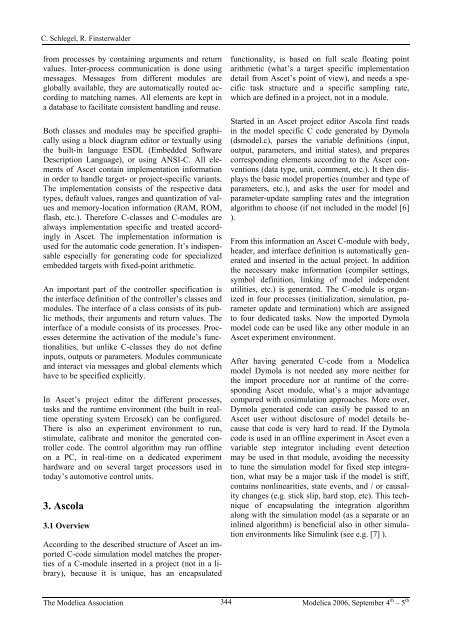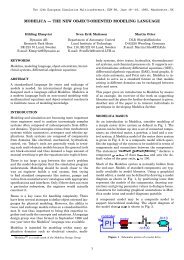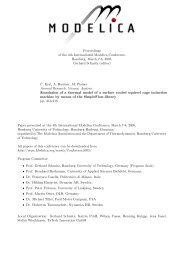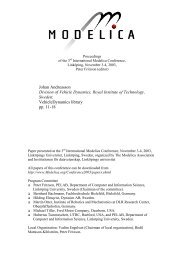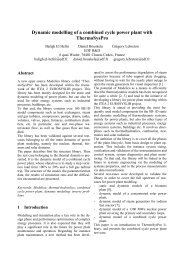Proceedings of the 5th International Modelica Conference Volume 2
Proceedings of the 5th International Modelica Conference Volume 2
Proceedings of the 5th International Modelica Conference Volume 2
You also want an ePaper? Increase the reach of your titles
YUMPU automatically turns print PDFs into web optimized ePapers that Google loves.
C. Schlegel, R. Finsterwalder<br />
from processes by containing arguments and return<br />
values. Inter-process communication is done using<br />
messages. Messages from different modules are<br />
globally available, <strong>the</strong>y are automatically routed according<br />
to matching names. All elements are kept in<br />
a database to facilitate consistent handling and reuse.<br />
Both classes and modules may be specified graphically<br />
using a block diagram editor or textually using<br />
<strong>the</strong> built-in language ESDL (Embedded S<strong>of</strong>tware<br />
Description Language), or using ANSI-C. All elements<br />
<strong>of</strong> Ascet contain implementation information<br />
in order to handle target- or project-specific variants.<br />
The implementation consists <strong>of</strong> <strong>the</strong> respective data<br />
types, default values, ranges and quantization <strong>of</strong> values<br />
and memory-location information (RAM, ROM,<br />
flash, etc.). Therefore C-classes and C-modules are<br />
always implementation specific and treated accordingly<br />
in Ascet. The implementation information is<br />
used for <strong>the</strong> automatic code generation. It’s indispensable<br />
especially for generating code for specialized<br />
embedded targets with fixed-point arithmetic.<br />
An important part <strong>of</strong> <strong>the</strong> controller specification is<br />
<strong>the</strong> interface definition <strong>of</strong> <strong>the</strong> controller’s classes and<br />
modules. The interface <strong>of</strong> a class consists <strong>of</strong> its public<br />
methods, <strong>the</strong>ir arguments and return values. The<br />
interface <strong>of</strong> a module consists <strong>of</strong> its processes. Processes<br />
determine <strong>the</strong> activation <strong>of</strong> <strong>the</strong> module’s functionalities,<br />
but unlike C-classes <strong>the</strong>y do not define<br />
inputs, outputs or parameters. Modules communicate<br />
and interact via messages and global elements which<br />
have to be specified explicitly.<br />
In Ascet’s project editor <strong>the</strong> different processes,<br />
tasks and <strong>the</strong> runtime environment (<strong>the</strong> built in realtime<br />
operating system Ercosek) can be configured.<br />
There is also an experiment environment to run,<br />
stimulate, calibrate and monitor <strong>the</strong> generated controller<br />
code. The control algorithm may run <strong>of</strong>fline<br />
on a PC, in real-time on a dedicated experiment<br />
hardware and on several target processors used in<br />
today’s automotive control units.<br />
3. Ascola<br />
3.1 Overview<br />
According to <strong>the</strong> described structure <strong>of</strong> Ascet an imported<br />
C-code simulation model matches <strong>the</strong> properties<br />
<strong>of</strong> a C-module inserted in a project (not in a library),<br />
because it is unique, has an encapsulated<br />
functionality, is based on full scale floating point<br />
arithmetic (what’s a target specific implementation<br />
detail from Ascet’s point <strong>of</strong> view), and needs a specific<br />
task structure and a specific sampling rate,<br />
which are defined in a project, not in a module.<br />
Started in an Ascet project editor Ascola first reads<br />
in <strong>the</strong> model specific C code generated by Dymola<br />
(dsmodel.c), parses <strong>the</strong> variable definitions (input,<br />
output, parameters, and initial states), and prepares<br />
corresponding elements according to <strong>the</strong> Ascet conventions<br />
(data type, unit, comment, etc.). It <strong>the</strong>n displays<br />
<strong>the</strong> basic model properties (number and type <strong>of</strong><br />
parameters, etc.), and asks <strong>the</strong> user for model and<br />
parameter-update sampling rates and <strong>the</strong> integration<br />
algorithm to choose (if not included in <strong>the</strong> model [6]<br />
).<br />
From this information an Ascet C-module with body,<br />
header, and interface definition is automatically generated<br />
and inserted in <strong>the</strong> actual project. In addition<br />
<strong>the</strong> necessary make information (compiler settings,<br />
symbol definition, linking <strong>of</strong> model independent<br />
utilities, etc.) is generated. The C-module is organized<br />
in four processes (initialization, simulation, parameter<br />
update and termination) which are assigned<br />
to four dedicated tasks. Now <strong>the</strong> imported Dymola<br />
model code can be used like any o<strong>the</strong>r module in an<br />
Ascet experiment environment.<br />
After having generated C-code from a <strong>Modelica</strong><br />
model Dymola is not needed any more nei<strong>the</strong>r for<br />
<strong>the</strong> import procedure nor at runtime <strong>of</strong> <strong>the</strong> corresponding<br />
Ascet module, what’s a major advantage<br />
compared with cosimulation approaches. More over,<br />
Dymola generated code can easily be passed to an<br />
Ascet user without disclosure <strong>of</strong> model details because<br />
that code is very hard to read. If <strong>the</strong> Dymola<br />
code is used in an <strong>of</strong>fline experiment in Ascet even a<br />
variable step integrator including event detection<br />
may be used in that module, avoiding <strong>the</strong> necessity<br />
to tune <strong>the</strong> simulation model for fixed step integration,<br />
what may be a major task if <strong>the</strong> model is stiff,<br />
contains nonlinearities, state events, and / or causality<br />
changes (e.g. stick slip, hard stop, etc). This technique<br />
<strong>of</strong> encapsulating <strong>the</strong> integration algorithm<br />
along with <strong>the</strong> simulation model (as a separate or an<br />
inlined algorithm) is beneficial also in o<strong>the</strong>r simulation<br />
environments like Simulink (see e.g. [7] ).<br />
The <strong>Modelica</strong> Association <strong>Modelica</strong> 2006, September 4 th – 5 th<br />
344


